Django框架搭建
Django搭建基本的操作流程,没有基础知识的讲解
一、Anaconda 虚拟环境安装
1. 安装url
Free Download | Anaconda
2. 环境配置 path
一般安装完成之后自动配置,自己看一眼,基本不需要配置。
1
2
3
4
5
6
7
| C:\Anaconda\Scripts
C:\Anaconda\Library\mingw-w64\bin
C:\Anaconda\Library\usr\bin
C:\Anaconda\Library\bin
|

3. 查看已有环境
conda env list
4. 新建环境
conda create -n mypython37 python=3.7
mypython37为环境名字,python=3.7版本号
5. 使用激活or切换
conda activate mypython37
6. 安装包
1
2
| pip install xxx
conda install xxx
|
二、PyCharm安装
社区版 PyCharm
三、Django框架配置
1.安装Django
pip install Django

2.创建Django项目
django-admin startproject HelloDjango

3.创建应用
先切换到你的项目目录下
1
2
3
| cd HelloDjango
python manage.py startapp myApp
|

4.使用Pycharm打开项目
新建两个文件夹
static
templates

1
2
3
4
5
6
7
8
9
10
11
12
13
14
15
16
17
18
19
20
21
22
| HelloDjango/ # 项目根目录
│
├── HelloDjango/ # 项目配置目录
│ ├── __init__.py
│ ├── settings.py # 项目配置文件
│ ├── urls.py # 项目的URL配置文件
│ └── wsgi.py # WSGI配置文件
│
├── myapp/ # 应用目录
│ ├── migrations/ # 数据库迁移文件目录
│ ├── __init__.py
│ ├── admin.py # 管理后台配置文件
│ ├── apps.py # 应用配置文件
│ ├── models.py # 模型定义文件
│ ├── tests.py # 测试文件
│ └── views.py # 视图函数文件
│
├── static/ # 存放静态文件(如 CSS、JavaScript、图片等)
│
├── templates/ # 存放模板文件(HTML)
│
└── manage.py # Django管理工具
|
5. settings . py 设置
注册之前创建的应用
1
2
3
4
5
6
7
| INSTALLED_APPS = [
······
'myApp’
]
|

1
2
3
| import os #在文件开头添加
'DIRS': [os.path.join(BASE_DIR, 'templates’)]
|
自带,查看自己项目是否有。
STATIC_URL = '/static/'
1
2
3
| LANGUAGE_CODE = 'zh-hans'
TIME_ZONE = 'Asia/Shanghai'
|
6. 启动项目
在pycharm中或者在之前Anaconda Prompt中都可以,前提是要切换到当前的项目目录下。

python manage.py runserver

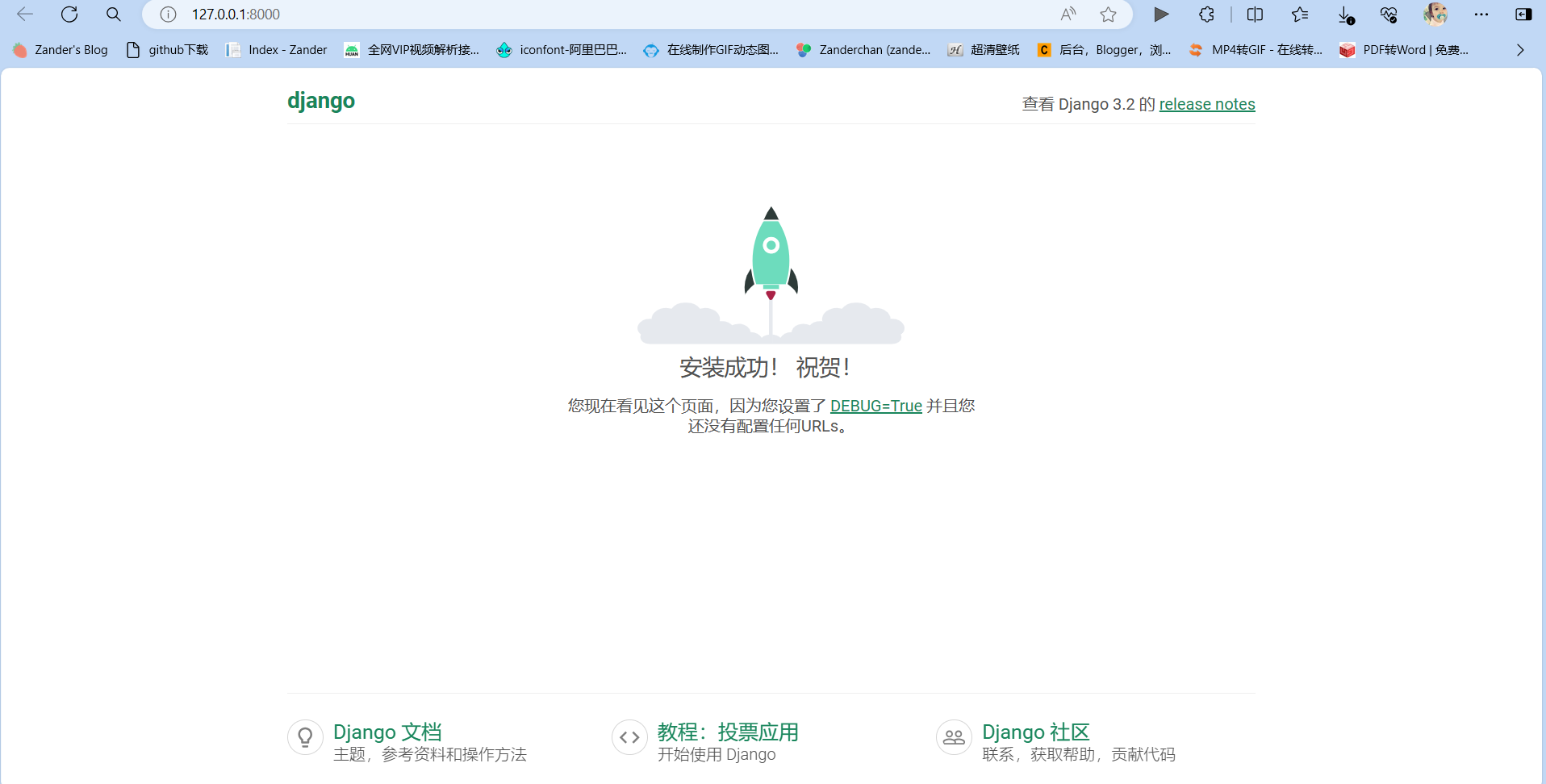
四、MySQL和Navicat 安装
MySQL 下载
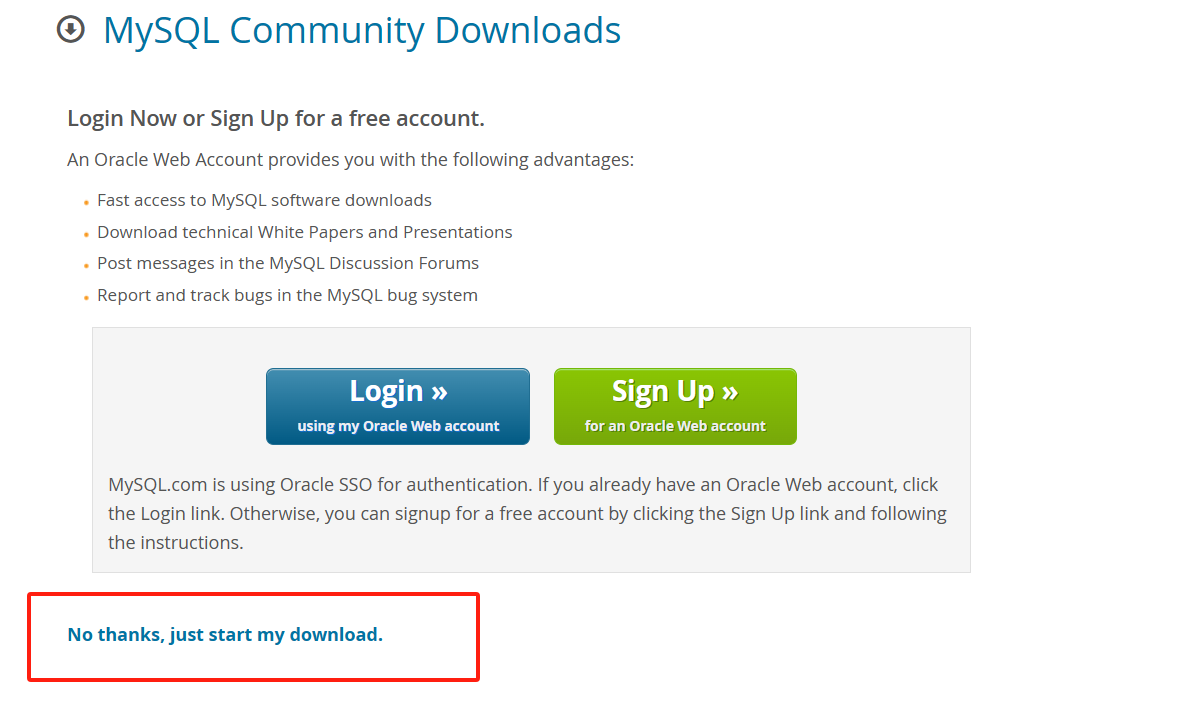
参考博客安装mysql
参考博客激活Navicat Premium15
参考博客激活Navicat Premium16
五、项目配置MySQL
1. 创建数据库
打开Navicat,新建MySQL连接。
用户名密码输入安装MySQL时的用户名密码。
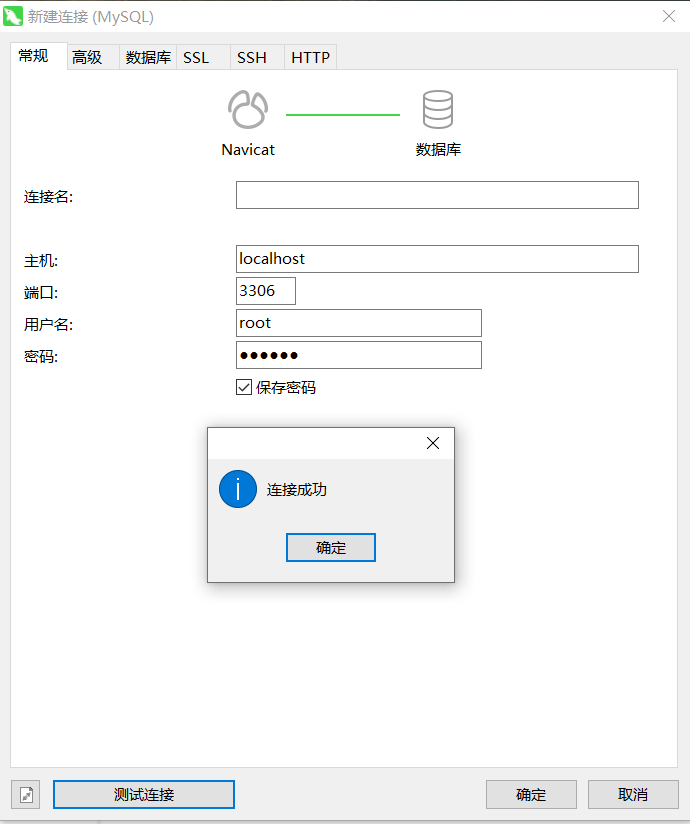
新建数据库,mydb名字自己取
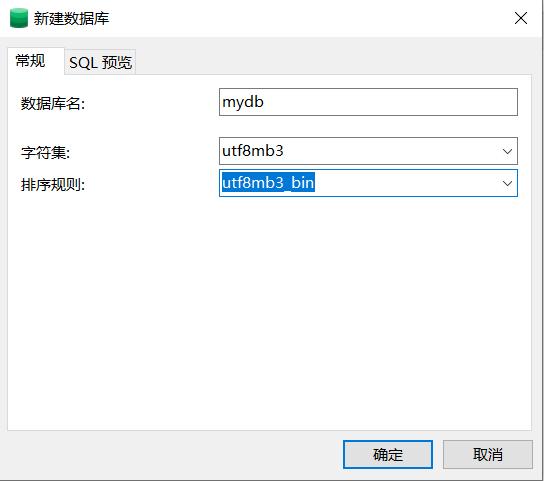
2.在项目中配置Django
settings.py
1
2
3
4
5
6
7
8
9
10
| DATABASES = {
'default': {
'ENGINE': 'django.db.backends.mysql',
'NAME': 'mydb', #你得数据库名字
'HOST': 'localhost',
'PORT': 3306,
'USER': 'root', #你的数据库账号
'PASSWORD': '123456' #密码
}
}
|
项目下的__init__.py(注意不是app下的)
1
2
| import pymysql
pymysql.install_as_MySQLdb()
|

有红色曲线,鼠标放上,安装pymysql

运行项目
1
| python manage.py runserver
|
没有报错,成功!!
3. 实体类 model . py
1
2
3
4
5
6
7
8
9
10
11
12
13
14
15
16
|
class MyUser(models.Model):
username = models.CharField(max_length=30, unique=True)
password = models.CharField(max_length=128)
join_date = models.DateTimeField(auto_now_add=True)
phone_number = models.CharField(max_length=11, blank=True, null=True)
avatar = models.ImageField(upload_to="avatars/", blank=True, null=True)
is_admin = models.BooleanField(default=False)
class Meta:
db_table = "user"
verbose_name = "用户基础信息"
verbose_name_plural = verbose_name
def __str__(self):
return self.username
|
python manage.py makemigrations

因为上面使用图片ImageField,才会报这个错误,按照他说的错误,安装对应的包。

再次执行生成迁移文件

python manage.py migrate
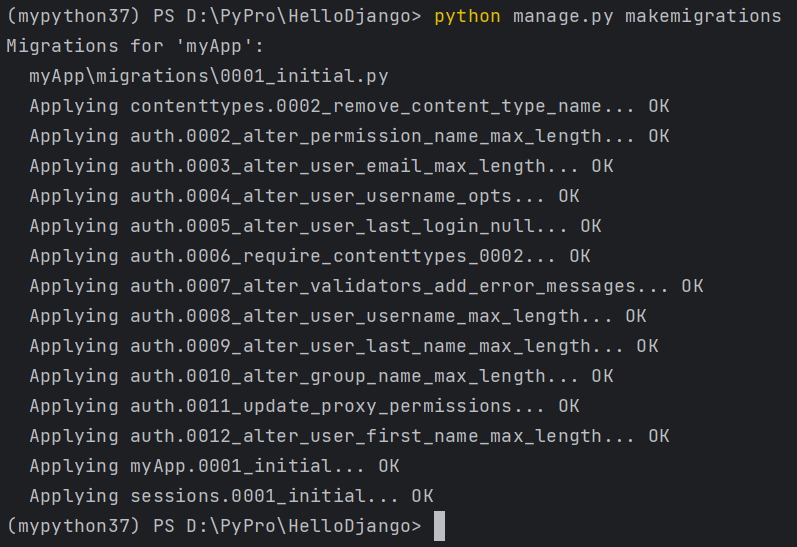
刷新表,出来了一系列的表,其中就有刚刚写的model : User
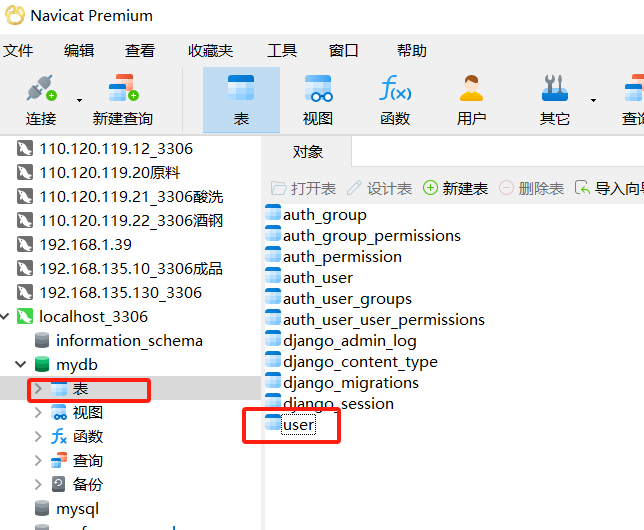
OK!大功告成了!!
六、路由 url. py
1
2
3
4
5
6
7
| from django.contrib import admin
from django.urls import path, include
urlpatterns = [
path('admin/', admin.site.urls),
path("", include("myApp.urls"))
]
|
- 2.复制url. py文件到myapp下
1
2
3
4
5
6
| from django.urls import path
from myApp import views
urlpatterns = [
path('index', views.index, name='index'),
]
|
七、视图 view. py
可以看到index下有一条黄色的曲线,含义为view.py中没有index这个view(视图),点击创建。

在view.py中创建了一个叫 index()的方法。
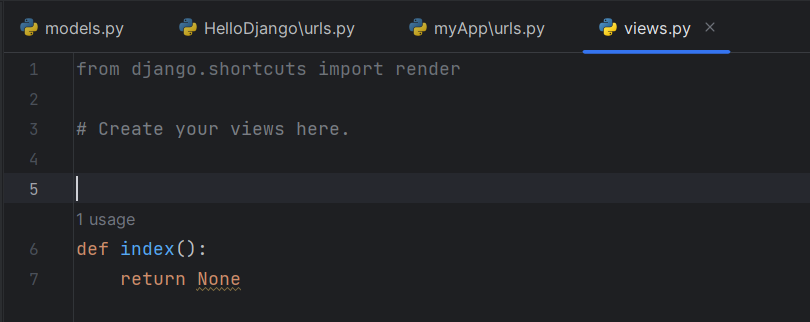
所以说,这个方法名字要和url的名字一一对应。
随便写一个返回看看效果
1
2
3
4
| from django.http import HttpResponse
def index(request):
return HttpResponse("Hello world django")
|
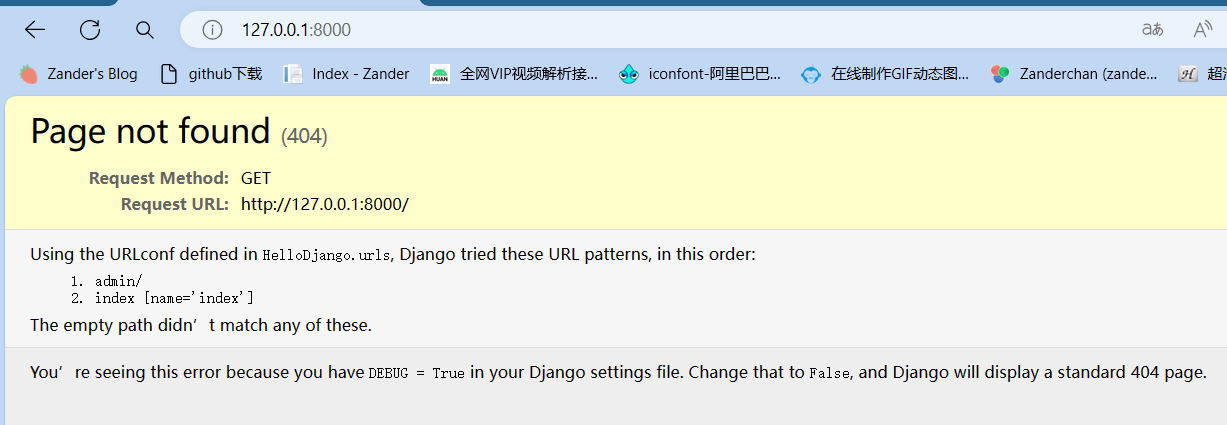
404未正确填写url
url填写正确
127.0.0.1:8000/index
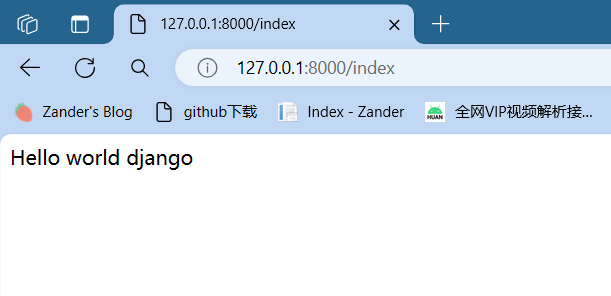
为了方便可以这么写
1
2
3
4
| urlpatterns = [
path('index', views.index, name='index'),
path('', views.index, name='index'),
]
|
这样空着也是跳转到index视图。
八、模板文件 templates
模板文件就是我们浏览网站看到的网页html文件。
在模板文件夹下新建一个HTML文件 index.html
前端框架使用 Bootstrap
1
2
3
4
5
6
7
8
9
10
11
12
13
14
| <!DOCTYPE html>
<html lang="en">
<head>
<meta charset="UTF-8">
<meta name="viewport" content="width=device-width, initial-scale=1, shrink-to-fit=no">
<link rel="stylesheet" href="https://cdn.jsdelivr.net/npm/bootstrap@4.6.2/dist/css/bootstrap.min.css" integrity="sha384-xOolHFLEh07PJGoPkLv1IbcEPTNtaed2xpHsD9ESMhqIYd0nLMwNLD69Npy4HI+N" crossorigin="anonymous">
<script src="https://cdn.jsdelivr.net/npm/jquery@3.5.1/dist/jquery.slim.min.js" integrity="sha384-DfXdz2htPH0lsSSs5nCTpuj/zy4C+OGpamoFVy38MVBnE+IbbVYUew+OrCXaRkfj" crossorigin="anonymous"></script>
<script src="https://cdn.jsdelivr.net/npm/bootstrap@4.6.2/dist/js/bootstrap.bundle.min.js" integrity="sha384-7ymO4nGrkm372HoSbq1OY2DP4pEZnMiA+E0F3zPr+JQQtQ82gQ1HPY3QIVtztVua" crossorigin="anonymous"></script>
<title>Title</title>
</head>
<body>
</body>
</html>
|
1
2
3
4
5
6
7
8
9
10
11
12
13
14
15
16
17
18
19
20
21
22
23
24
25
26
27
28
29
30
31
32
| <body>
<table class="table table-hover">
<thead>
<tr>
<th scope="col">#</th>
<th scope="col">First</th>
<th scope="col">Last</th>
<th scope="col">Handle</th>
</tr>
</thead>
<tbody>
<tr>
<th scope="row">1</th>
<td>Mark</td>
<td>Otto</td>
<td>@mdo</td>
</tr>
<tr>
<th scope="row">2</th>
<td>Jacob</td>
<td>Thornton</td>
<td>@fat</td>
</tr>
<tr>
<th scope="row">3</th>
<td colspan="2">Larry the Bird</td>
<td>@twitter</td>
</tr>
</tbody>
</table>
</body>
</html>
|
1
2
| def index(request):
return render(request, "index.html")
|

显示出来的是一个bootstrap格式的表格,即表示bootstrap前端框架使用成功!
九、项目中使用MySQL数据库简单示例

join_date 2023-10-30 00:29:58.469105
手动在这个user表里添加了两条数据,查询这个表的数据,显示在网站上的表格里。
1.查询
view
1
2
3
| def index(request):
users = MyUser.objects.all()
return render(request, "index.html", {'users': users})
|
index.html
1
2
3
4
5
6
7
8
9
10
11
12
13
14
15
16
17
18
19
20
| <table class="table table-hover">
<thead>
<tr>
<th scope="col">#</th>
<th scope="col">账号</th>
<th scope="col">密码</th>
<th scope="col">日期</th>
</tr>
</thead>
<tbody>
{% for user in users %}
<tr>
<th scope="row">{{ user.id }}</th>
<td>{{user.username}}</td>
<td>{{user.password}}</td>
<td>{{user.join_date}}</td>
</tr>
{% endfor %}
</tbody>
</table>
|
{% %} {{ }}为Django模板语言
整个操作流程就是这样,有条件的查询参考博客很清晰。
2.修改
1)新建详情界面
修改模板index文件,添加了详情按钮
1
2
3
4
5
6
7
8
9
10
11
12
13
14
15
16
17
18
19
20
21
22
23
24
| <table class="table table-hover">
<thead>
<tr>
<th scope="col">序号</th>
<th scope="col">账号</th>
<th scope="col">密码</th>
<th scope="col">日期</th>
<th scope="col">操作</th>
</tr>
</thead>
<tbody>
{% for user in users %}
<tr>
<th scope="row">{{ user.id }}</th>
<td>{{user.username}}</td>
<td>{{user.password}}</td>
<td>{{user.join_date}}</td>
<td>
<a href="/detail?user_id={{ user.id }}"><button type="button" class="btn btn-primary">详情</button></a>
</td>
</tr>
{% endfor %}
</tbody>
</table>
|
详情按钮加超链接,url后面跟user_id参数
新建detail.html,设置路由,建立详情视图
1
2
3
4
5
6
7
|
path('detail', views.detail, name='detail'),
def detail(request):
return render(request, "detail.html")
|
detail.html
1
2
3
4
5
6
7
8
9
10
11
12
13
14
15
16
17
18
19
20
21
22
23
24
25
26
27
28
29
30
31
32
33
34
35
36
37
38
39
| <!DOCTYPE html>
<html lang="cn">
<head>
<meta charset="UTF-8">
<meta name="viewport" content="width=device-width, initial-scale=1, shrink-to-fit=no">
<link rel="stylesheet" href="https://cdn.jsdelivr.net/npm/bootstrap@4.6.2/dist/css/bootstrap.min.css"
integrity="sha384-xOolHFLEh07PJGoPkLv1IbcEPTNtaed2xpHsD9ESMhqIYd0nLMwNLD69Npy4HI+N" crossorigin="anonymous">
<script src="https://cdn.jsdelivr.net/npm/jquery@3.5.1/dist/jquery.slim.min.js"
integrity="sha384-DfXdz2htPH0lsSSs5nCTpuj/zy4C+OGpamoFVy38MVBnE+IbbVYUew+OrCXaRkfj"
crossorigin="anonymous"></script>
<script src="https://cdn.jsdelivr.net/npm/bootstrap@4.6.2/dist/js/bootstrap.bundle.min.js"
integrity="sha384-7ymO4nGrkm372HoSbq1OY2DP4pEZnMiA+E0F3zPr+JQQtQ82gQ1HPY3QIVtztVua"
crossorigin="anonymous"></script>
<title>详情</title>
</head>
<body>
<form>
<div class="form-group">
<label for="id" class="sr-only">id</label>
<input type="text" readonly class="form-control-plaintext" id="id" name="id" value="{{ user.id }}">
</div>
<div class="form-group">
<label for="username">用户名</label>
<input type="text" class="form-control" id="username" name="username" value="{{ user.username }}">
</div>
<div class="form-group">
<label for="password">密码</label>
<input type="password" class="form-control" id="password" name="password" value="{{ user.password }}">
</div>
<div class="form-group">
<label for="join_date" class="sr-only">创建时间</label>
<input type="text" readonly class="form-control-plaintext" id="join_date" name="join_date" value="{{ user.join_date }}">
</div>
<button type="button" class="btn btn-primary">修改</button>
<button type="button" class="btn btn-danger">删除</button>
</form>
</body>
</html>
|

2)修改删除功能
修改detail模板文件
1
2
3
4
5
6
7
8
9
10
11
12
13
14
15
16
17
18
19
20
21
22
23
| <body>
<form method="post" action="detail_update">
{% csrf_token %}
<div class="form-group">
<label for="id" class="sr-only">id</label>
<input type="text" readonly class="form-control-plaintext" id="id" name="id" value="{{ user.id }}">
</div>
<div class="form-group">
<label for="username">用户名</label>
<input type="text" class="form-control" id="username" name="username" value="{{ user.username }}">
</div>
<div class="form-group">
<label for="password">密码</label>
<input type="password" class="form-control" id="password" name="password" value="{{ user.password }}">
</div>
<div class="form-group">
<label for="join_date" class="sr-only">创建时间</label>
<input type="text" readonly class="form-control-plaintext" id="join_date" name="join_date" value="{{ user.join_date }}">
</div>
<button type="submit" class="btn btn-primary">修改</button>
<a href="detail_del?user_id={{ user.id }}"><button type="button" class="btn btn-danger">删除</button></a>
</form>
</body>
|
{% csrf_token %} POST请求需要在表单中包含一个CSRF令牌。
路由url
1
2
| path('detail_update', views.detail_update, name='detail_update'),
path('detail_del', views.detail_del, name='detail_del'),
|
视图view
1
2
3
4
5
6
7
8
9
| def detail_update(request):
user_id = request.POST.get('id')
user = MyUser.objects.get(pk=user_id)
username = request.POST.get('username')
password = request.POST.get('password')
user.username = username
user.password = password
user.save()
return redirect('index')
|
1
2
3
4
5
| def detail_del(request):
user_id = request.GET.get('user_id')
user = MyUser.objects.get(pk=user_id)
user.delete()
return redirect('index')
|
3.添加
index.html 加一个按钮
1
| <a href="addUser.html"><button type="button" class="btn btn-success">添加</button></a>
|
创建addUser.html
1
2
3
4
5
6
7
8
9
10
11
12
13
14
15
16
17
18
19
20
21
22
23
24
25
26
27
28
29
30
31
| <!DOCTYPE html>
<html lang="en">
<head>
<meta charset="UTF-8">
<meta name="viewport" content="width=device-width, initial-scale=1, shrink-to-fit=no">
<link rel="stylesheet" href="https://cdn.jsdelivr.net/npm/bootstrap@4.6.2/dist/css/bootstrap.min.css"
integrity="sha384-xOolHFLEh07PJGoPkLv1IbcEPTNtaed2xpHsD9ESMhqIYd0nLMwNLD69Npy4HI+N" crossorigin="anonymous">
<script src="https://cdn.jsdelivr.net/npm/jquery@3.5.1/dist/jquery.slim.min.js"
integrity="sha384-DfXdz2htPH0lsSSs5nCTpuj/zy4C+OGpamoFVy38MVBnE+IbbVYUew+OrCXaRkfj"
crossorigin="anonymous"></script>
<script src="https://cdn.jsdelivr.net/npm/bootstrap@4.6.2/dist/js/bootstrap.bundle.min.js"
integrity="sha384-7ymO4nGrkm372HoSbq1OY2DP4pEZnMiA+E0F3zPr+JQQtQ82gQ1HPY3QIVtztVua"
crossorigin="anonymous"></script>
<title>添加</title>
</head>
<body>
<form method="post" action="add_user_post">
{% csrf_token %}
<div class="form-group">
<label for="username">用户名</label>
<input type="text" class="form-control" id="username" name="username" required>
</div> <div class="form-group">
<label for="password">密码</label>
<input type="password" class="form-control" id="password" name="password" required>
</div>
<button type="submit" class="btn btn-primary">添加</button>
</form>
</body>
</html>
|
路由
1
2
| path('add_user', views.add_user, name='add_user'),
path('add_user_post', views.add_user_post, name='add_user_post'),
|
视图
1
2
3
4
5
6
7
8
9
| def add_user(request):
return render(request, "addUser.html")
def add_user_post(request):
username = request.POST.get('username')
password = request.POST.get('password')
MyUser.objects.create(username=username, password=password)
return redirect('index')
|

至此,添加功能完成。
十、完整代码
settings.py
1
2
3
4
5
6
7
8
9
10
11
12
13
14
15
16
17
18
19
20
21
22
23
24
25
26
27
28
29
30
31
32
33
34
35
36
37
38
39
40
41
42
43
44
45
46
47
48
49
50
51
52
53
54
55
56
57
58
59
60
61
62
63
64
65
66
67
68
69
70
71
72
73
74
75
76
77
78
79
80
81
82
83
84
85
86
87
88
89
90
91
92
93
94
95
96
97
98
99
100
101
102
103
104
105
106
107
108
109
110
111
112
113
114
115
116
117
118
119
120
|
import os
from pathlib import Path
BASE_DIR = Path(__file__).resolve().parent.parent
SECRET_KEY = 'django-insecure-^ko%qqehu@$)-&i$-4iyq#^nbg3jzz_5!f#(h^99d@c#154nni'
DEBUG = True
ALLOWED_HOSTS = []
INSTALLED_APPS = [
'django.contrib.admin',
'django.contrib.auth',
'django.contrib.contenttypes',
'django.contrib.sessions',
'django.contrib.messages',
'django.contrib.staticfiles',
'myApp'
]
MIDDLEWARE = [
'django.middleware.security.SecurityMiddleware',
'django.contrib.sessions.middleware.SessionMiddleware',
'django.middleware.common.CommonMiddleware',
'django.middleware.csrf.CsrfViewMiddleware',
'django.contrib.auth.middleware.AuthenticationMiddleware',
'django.contrib.messages.middleware.MessageMiddleware',
'django.middleware.clickjacking.XFrameOptionsMiddleware',
]
ROOT_URLCONF = 'HelloDjango.urls'
TEMPLATES = [
{
'BACKEND': 'django.template.backends.django.DjangoTemplates',
'DIRS': [os.path.join(BASE_DIR, 'templates')],
'APP_DIRS': True,
'OPTIONS': {
'context_processors': [
'django.template.context_processors.debug',
'django.template.context_processors.request',
'django.contrib.auth.context_processors.auth',
'django.contrib.messages.context_processors.messages',
],
},
},
]
WSGI_APPLICATION = 'HelloDjango.wsgi.application'
DATABASES = {
'default': {
'ENGINE': 'django.db.backends.mysql',
'NAME': 'mydb',
'HOST': 'localhost',
'PORT': 3306,
'USER': 'root',
'PASSWORD': '123456'
}
}
AUTH_PASSWORD_VALIDATORS = [
{
'NAME': 'django.contrib.auth.password_validation.UserAttributeSimilarityValidator',
},
{
'NAME': 'django.contrib.auth.password_validation.MinimumLengthValidator',
},
{
'NAME': 'django.contrib.auth.password_validation.CommonPasswordValidator',
},
{
'NAME': 'django.contrib.auth.password_validation.NumericPasswordValidator',
},
]
LANGUAGE_CODE = 'zh-hans'
TIME_ZONE = 'Asia/Shanghai'
USE_I18N = True
USE_L10N = True
USE_TZ = True
STATIC_URL = '/static/'
DEFAULT_AUTO_FIELD = 'django.db.models.BigAutoField'
|
HelloProject/url.py
1
2
3
4
5
6
7
| from django.contrib import admin
from django.urls import path, include
urlpatterns = [
path('admin/', admin.site.urls),
path("", include("myApp.urls"))
]
|
myApp/url.py
1
2
3
4
5
6
7
8
9
10
11
12
13
| from django.urls import path
from myApp import views
urlpatterns = [
path('index', views.index, name='index'),
path('', views.index, name='index'),
path('detail', views.detail, name='detail'),
path('detail_update', views.detail_update, name='detail_update'),
path('detail_del', views.detail_del, name='detail_del'),
path('add_user', views.add_user, name='add_user'),
path('add_user_post', views.add_user_post, name='add_user_post'),
]
|
model.py
1
2
3
4
5
6
7
8
9
10
11
12
13
14
15
16
17
18
19
20
21
| from django.db import models
class MyUser(models.Model):
username = models.CharField(max_length=30, unique=True)
password = models.CharField(max_length=128)
join_date = models.DateTimeField(auto_now_add=True)
phone_number = models.CharField(max_length=11, blank=True, null=True)
avatar = models.ImageField(upload_to="avatars/", blank=True, null=True)
is_admin = models.BooleanField(default=False)
class Meta:
db_table = "user"
verbose_name = "用户基础信息"
verbose_name_plural = verbose_name
def __str__(self):
return self.username
|
view.py
1
2
3
4
5
6
7
8
9
10
11
12
13
14
15
16
17
18
19
20
21
22
23
24
25
26
27
28
29
30
31
32
33
34
35
36
37
38
39
40
41
42
43
44
45
46
47
| from django.shortcuts import render, redirect
from django.http import HttpResponse
from myApp.models import MyUser
def index(request):
users = MyUser.objects.all()
return render(request, "index.html", {'users': users})
def detail(request):
user_id = request.GET.get('user_id')
user = MyUser.objects.get(pk=user_id)
return render(request, "detail.html", {'user': user})
def detail_update(request):
user_id = request.POST.get('id')
user = MyUser.objects.get(pk=user_id)
username = request.POST.get('username')
password = request.POST.get('password')
user.username = username
user.password = password
user.save()
return redirect('index')
def detail_del(request):
user_id = request.GET.get('user_id')
user = MyUser.objects.get(pk=user_id)
user.delete()
return redirect('index')
def add_user(request):
return render(request, "addUser.html")
def add_user_post(request):
username = request.POST.get('username')
password = request.POST.get('password')
MyUser.objects.create(username=username, password=password)
return redirect('index')
|
index.html
1
2
3
4
5
6
7
8
9
10
11
12
13
14
15
16
17
18
19
20
21
22
23
24
25
26
27
28
29
30
31
32
33
34
35
36
37
38
| <!DOCTYPE html>
<html lang="en">
<head>
<meta charset="UTF-8">
<meta name="viewport" content="width=device-width, initial-scale=1, shrink-to-fit=no">
<link rel="stylesheet" href="https://cdn.jsdelivr.net/npm/bootstrap@4.6.2/dist/css/bootstrap.min.css"
integrity="sha384-xOolHFLEh07PJGoPkLv1IbcEPTNtaed2xpHsD9ESMhqIYd0nLMwNLD69Npy4HI+N" crossorigin="anonymous">
<script src="https://cdn.jsdelivr.net/npm/jquery@3.5.1/dist/jquery.slim.min.js"
integrity="sha384-DfXdz2htPH0lsSSs5nCTpuj/zy4C+OGpamoFVy38MVBnE+IbbVYUew+OrCXaRkfj"
crossorigin="anonymous"></script>
<script src="https://cdn.jsdelivr.net/npm/bootstrap@4.6.2/dist/js/bootstrap.bundle.min.js"
integrity="sha384-7ymO4nGrkm372HoSbq1OY2DP4pEZnMiA+E0F3zPr+JQQtQ82gQ1HPY3QIVtztVua"
crossorigin="anonymous"></script>
<title>Title</title>
</head>
<body>
<a href="add_user"><button type="button" class="btn btn-success">添加</button></a>
<table class="table table-hover">
<thead> <tr> <th scope="col">序号</th>
<th scope="col">账号</th>
<th scope="col">密码</th>
<th scope="col">日期</th>
<th scope="col">操作</th>
</tr> </thead> <tbody> {% for user in users %}
<tr>
<th scope="row">{{ user.id }}</th>
<td>{{user.username}}</td>
<td>{{user.password}}</td>
<td>{{user.join_date}}</td>
<td> <a href="/detail?user_id={{ user.id }}"><button type="button" class="btn btn-primary">详情</button></a>
</td>
</tr> {% endfor %}
</tbody>
</table>
</body>
</html>
|
detail.html
1
2
3
4
5
6
7
8
9
10
11
12
13
14
15
16
17
18
19
20
21
22
23
24
25
26
27
28
29
30
31
32
33
34
35
36
| <!DOCTYPE html>
<html lang="cn">
<head>
<meta charset="UTF-8">
<meta name="viewport" content="width=device-width, initial-scale=1, shrink-to-fit=no">
<link rel="stylesheet" href="https://cdn.jsdelivr.net/npm/bootstrap@4.6.2/dist/css/bootstrap.min.css"
integrity="sha384-xOolHFLEh07PJGoPkLv1IbcEPTNtaed2xpHsD9ESMhqIYd0nLMwNLD69Npy4HI+N" crossorigin="anonymous">
<script src="https://cdn.jsdelivr.net/npm/jquery@3.5.1/dist/jquery.slim.min.js"
integrity="sha384-DfXdz2htPH0lsSSs5nCTpuj/zy4C+OGpamoFVy38MVBnE+IbbVYUew+OrCXaRkfj"
crossorigin="anonymous"></script>
<script src="https://cdn.jsdelivr.net/npm/bootstrap@4.6.2/dist/js/bootstrap.bundle.min.js"
integrity="sha384-7ymO4nGrkm372HoSbq1OY2DP4pEZnMiA+E0F3zPr+JQQtQ82gQ1HPY3QIVtztVua"
crossorigin="anonymous"></script>
<title>详情</title>
</head>
<body>
<form method="post" action="detail_update">
{% csrf_token %}
<div class="form-group">
<label for="id" class="sr-only">id</label>
<input type="text" readonly class="form-control-plaintext" id="id" name="id" value="{{ user.id }}">
</div> <div class="form-group">
<label for="username">用户名</label>
<input type="text" class="form-control" id="username" name="username" value="{{ user.username }}">
</div> <div class="form-group">
<label for="password">密码</label>
<input type="password" class="form-control" id="password" name="password" value="{{ user.password }}">
</div>
<div class="form-group">
<label for="join_date" class="sr-only">创建时间</label>
<input type="text" readonly class="form-control-plaintext" id="join_date" name="join_date" value="{{ user.join_date }}">
</div> <button type="submit" class="btn btn-primary">修改</button>
<a href="detail_del?user_id={{ user.id }}"><button type="button" class="btn btn-danger">删除</button></a>
</form>
</body>
</html>
|
addUser.html
1
2
3
4
5
6
7
8
9
10
11
12
13
14
15
16
17
18
19
20
21
22
23
24
25
26
27
28
29
30
31
| <!DOCTYPE html>
<html lang="en">
<head>
<meta charset="UTF-8">
<meta name="viewport" content="width=device-width, initial-scale=1, shrink-to-fit=no">
<link rel="stylesheet" href="https://cdn.jsdelivr.net/npm/bootstrap@4.6.2/dist/css/bootstrap.min.css"
integrity="sha384-xOolHFLEh07PJGoPkLv1IbcEPTNtaed2xpHsD9ESMhqIYd0nLMwNLD69Npy4HI+N" crossorigin="anonymous">
<script src="https://cdn.jsdelivr.net/npm/jquery@3.5.1/dist/jquery.slim.min.js"
integrity="sha384-DfXdz2htPH0lsSSs5nCTpuj/zy4C+OGpamoFVy38MVBnE+IbbVYUew+OrCXaRkfj"
crossorigin="anonymous"></script>
<script src="https://cdn.jsdelivr.net/npm/bootstrap@4.6.2/dist/js/bootstrap.bundle.min.js"
integrity="sha384-7ymO4nGrkm372HoSbq1OY2DP4pEZnMiA+E0F3zPr+JQQtQ82gQ1HPY3QIVtztVua"
crossorigin="anonymous"></script>
<title>添加</title>
</head>
<body>
<form method="post" action="add_user_post">
{% csrf_token %}
<div class="form-group">
<label for="username">用户名</label>
<input type="text" class="form-control" id="username" name="username" required>
</div> <div class="form-group">
<label for="password">密码</label>
<input type="password" class="form-control" id="password" name="password" required>
</div>
<button type="submit" class="btn btn-primary">添加</button>
</form>
</body>
</html>
|


























